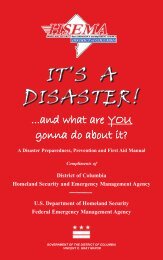disaster 5th 1108_5th ed 2011 - Homeland Security and Emergency ...
disaster 5th 1108_5th ed 2011 - Homeland Security and Emergency ...
disaster 5th 1108_5th ed 2011 - Homeland Security and Emergency ...
Create successful ePaper yourself
Turn your PDF publications into a flip-book with our unique Google optimized e-Paper software.
What is the most dangerous part of a nuclear attack<br />
Both the initial nuclear radiation <strong>and</strong> residual nuclear radiation (also call<strong>ed</strong><br />
radioactive fallout) are extremely dangerous. But as the materials decay or<br />
spread out radiation levels will drop.<br />
Types of radiation - Nuclear radiation has 3 main types of radiation ...<br />
• alpha - can be shield<strong>ed</strong> by a sheet of paper or by human<br />
skin. If alpha particles are inhal<strong>ed</strong>, ingest<strong>ed</strong>, or enter body<br />
through a cut, they can cause damage to tissues <strong>and</strong> cells.<br />
• beta - can be stopp<strong>ed</strong> by skin or a thicker shield (like<br />
wood). Beta particles can cause serious damage to internal<br />
organs if ingest<strong>ed</strong> or inhal<strong>ed</strong>, <strong>and</strong> could cause eye damage<br />
or possible skin burns.<br />
• gamma - most dangerous since gamma rays can penetrate<br />
the entire body <strong>and</strong> cause cell damage throughout your<br />
organs, blood <strong>and</strong> bones. Since radiation does not stimulate<br />
nerve cells you may not feel anything while your body<br />
absorbs it. Exposure to high levels of gamma rays can lead<br />
to radiation sickness or death which is why it is critical to<br />
seek shelter from fallout in a facility with thick shielding!<br />
Detecting radiation - You cannot see, smell, taste or feel radiation, but<br />
special instruments can detect even the smallest levels of radiation. After an<br />
incident, authorities will monitor levels of radioactivity to determine the<br />
potential danger. However, since it may take days or weeks before First<br />
Responders could get to you, please consider purchasing detection devices<br />
for your home <strong>and</strong> Disaster Supplies Kits. Having these devices h<strong>and</strong>y<br />
during a crisis or attack could save your life!<br />
• survey meter - measures rate of exposure or intensity of<br />
radiation at that specific location if you stay<strong>ed</strong> there for an<br />
hour ... like a spe<strong>ed</strong>ometer in a car (cost: $300-$1,000+)<br />
• dosimeter - a pen-like device you can wear that measures<br />
total dose or accumulat<strong>ed</strong> exposure to radiation as you<br />
move around (ne<strong>ed</strong>s a charger too - cost: $45-$65+ each)<br />
• KFM kit - (Kearny Fallout Meter) measures radiation<br />
more accurately than most instruments since it’s charg<strong>ed</strong><br />
electrostatically. Free plans online or available as a lowcost<br />
kit ($40-$75). And a great science project for kids.<br />
• NukAlert TM - a patent<strong>ed</strong> personal radiation meter, monitor<br />
<strong>and</strong> alarm small enough to fit on a key chain. The unit<br />
makes chirping sounds if it detects radiation. (cost: $160)<br />
• RADSticker TM - postage stamp siz<strong>ed</strong> card (cost: $2-$5 ea)<br />
Measuring radiation - Radiation was measur<strong>ed</strong> in units call<strong>ed</strong> roentgens<br />
112 www.itsa<strong>disaster</strong>.net or call 1-888-999-4325





